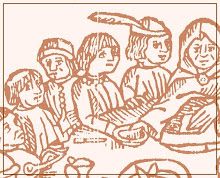This is for the class on the mediaeval bestiary that I am teaching to a bunch of year 10 students tomorrow - I will give them this description, without telling them the animal, and have them draw it. The results should go some way to explaining why the crocodile in bestiaries variously resembles a dog, a fish, a large bird and a snake. And the point is also, of course, that the bestiary entry is really about the meaning of the animal, not (what we would consider) the animal itself. A large part of the aim of this lesson is to teach them about allegory as a basic tool of mediaeval thought.
They are a very good group - they guessed today what animal 'vellum' was made from based on the name, argued about whether Henry VIII was a Protestant or a Catholic, volunteered the printing press as a possible date/event to mark the end of the Middle Ages then (as a group) came up with good reasons as to why that might be so significant a cultural shift (then one pointed out that we're in the middle of a similar revolution at the moment, re. internet and digital information, completely pre-empting me!), asked spontaneously about several myths of the Middle Ages (how real was King Arthur, did they think the world was flat) and managed to volunteer all of the languages spoken in mediaeval England without prompting. And when you have the answers "Middle English?" "No, OLD English." "French!" "No, they spoke French in France," and "Latin", it is very satisfying to be able to say "you are all absolutely correct, here's why".
Kangaroo follows.
Of course, there ought to be a few fanciful etymologies for the name, but firstly that would give it away, and secondly I think even Isidore would be stretched to come up with a Greek+Latin derivation for a word that derives from an English misinterpretation of an Aboriginal phrase.
This creature has the face of a sheep and the ears and fur of a rabbit. Its tail is still like a log, and it is stiff so that the animal can stand upon it.
Its back is hunched like a hill, and it has hands like a child's, but black.
Its eyelashes are long and thick like a camel's, to keep out sand and dust. When it is hot, it licks itself like a cat.
The ape gives birth to two children at once, and it loves one while it hates the other; but this creature has always one child older than the other, and loves both equally. For it feeds each according to its needs, giving the elder one kind of milk from one teat, even while it feeds the younger another milk from a second teat. By this we understand that each man should be taught the Word of God according to his capacity to understand them. He who is young and innocent is best taught with simple fables and allegories of beasts, but he who knows more of the Lord and can better understand his ways may be nourished on the words of the Fathers of the Church.
When this creature bends its head to eat, it stands upon four legs, and, its head being low to the ground, can see nothing about it, for its eyes are covered by the grasses. But when it stands tall it can see for many miles, and no predator may take it by surprise. Thus the devil creeps upon those who bury their heads in gluttony and desire, but those who stand tall and see clearly he cannot surprise.


.jpg)

